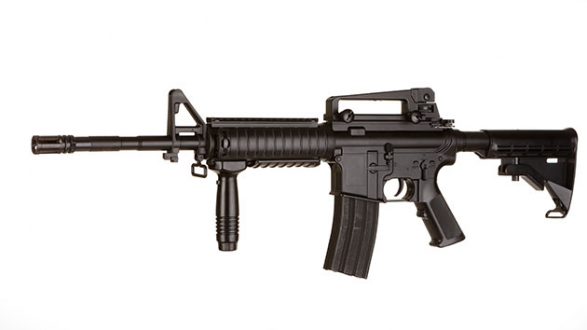
 iStock/Thinkstock(LAS VEGAS)– Investigators in Las Vegas are still combing through the blood-stained concert grounds and tracing the history of the cache of 23 guns found inside Stephen Paddock’s 32nd floor suite.
iStock/Thinkstock(LAS VEGAS)– Investigators in Las Vegas are still combing through the blood-stained concert grounds and tracing the history of the cache of 23 guns found inside Stephen Paddock’s 32nd floor suite.
While the details on the weapons Paddock used during his deadly 11-minute rampage that killed 59 and injured more than 500 are still not known, one key element has emerged: His possession of a dozen high-powered weapons fitted with so-called bump or slide stocks.
This legal accessory comes in kits that sell for as little as $99 online and can increase the rate of firing speed, and with it the potential lethality, to mimic automatic gunfire.
So far, it’s unknown if weapons equipped with bump stocks qualify as machine guns, or if Paddock may have had weapons modified in some other way or even if he managed to obtain fully-automatic weapons. But the terrifying footage of the deadliest mass shooting in U.S. history, in which rapid gun bursts can be heard, has sparked a debate about the legality of automatic weapons in the U.S.
By definition, a machine gun is an automatic firearm that rapidly shoots a cluster of rounds of ammunition per minute.
Since the 18th century, machine guns have earned a prominent place in history and over time changed modern warfare.
The first machine gun, called a defense or Puckle gun, was invented in the 1700s by an Englishman named James Puckle.
A weapon fired by a turn of a crank and was created by Richard Gatling and altered warfare during the Civil War after it was introduced in 1862.
In 1885, Hiram Maxim presented the first fully-automatic machine gun, which could fire 500 rounds per minute.
Soon after came the submachine gun known as the anti-bandit gun or Tommy Gun.
The iconic weapon was created by Brigadier General John Taliaferro Thompson, a West Point alum who later tested .45 caliber cartridge ammunition rounds on human cadavers and live cattle.
He later used the same cartridges for his prototypes that were first called the Persuader and Annihilator.
By the 1920s Thompson’s gun was shopped around Europe and earned the monikers Tommy Guns or Chicago Typewriters and became synonymous with gang violence of the era.
From 1936 to 1986
The federal government started regulating and keeping records of machine guns back when it passed the National Firearms Act of 1934.
That law mandated strict guidelines for manufacturers and put them in place for owners to register their machine guns.
Then in 1986, the feds imposed the Firearm Owners Protection Act which expanded on the original law.
It also banned possession and transfer of new automatic firearms and parts that fire bullets without stopping once the trigger is depressed.
Critically, legal machine guns must be manufactured before May 19, 1986, the cutoff date imposed by the Bureau of Alcohol, Tobacco, Firearms, & Explosives (ATF).
Because of their scarcity, legal machine guns are very expensive, still require the original 1934 Machine Gun Tax stamp of $200 and the owner or trader must undergo extensive background checks and also permit the federal government to conduct searches.
Law enforcement agencies and the military are not subject to the same stringent measures.
Registered machine gun dealers are also permitted to possess samples to sell to military and law enforcement customers.
Federal and state laws
More legislation regarding machine guns exist at the state level and can impose long prison sentences.
In fact, fines of up to $250,000 and prison sentences up to 10 years can be instituted to those in possession of an unregistered machine gun.
Connecticut is a small state of 4 million residents but possesses the greatest share of machine guns nationwide, with 52,965 registered. Their machine gun law details that the parts of a machine gun must be registered with the ATF.
“Connecticut residents may purchase machine guns if they are capable of a ‘full automatic only’ rate of fire. Any select fire weapon is considered an ‘Assault Weapon’ and is prohibited by State Law,” according to their gun laws.
Nevada follows the federal guidelines: machine guns can be possessed if they are registered and manufactured before 1986.
As of April 2017, there were over 11,000 machine guns registered in the same state where Adam Lanza committed one of the nation’s deadliest mass shootings when he killed 26 people, including 20 first graders.
But these guns mostly aren’t being handled by the general public.
“[Many are] in the hands of law enforcement, and they have to register too. Those are part of the high number,” Lindsay Nichols, the Federal Policy Director from the Law Center to Prevent Gun Violence, a gun law advocacy organization told ABC News.
Texas falls in second to Connecticut with 36,534 machine guns registered among a population of almost 28 million.
The state has the most federally registered weapons with almost 590,000.
The ATF, according to the 2017 Commencement Report, confirmed there were 630,019 machine guns registered nationwide. A spokesperson for the ATF said that the number of machine gun owners nationwide is not known.
Semiautomatic rifles are legal to obtain in Nevada, and in most states.
Copyright © 2017, ABC Radio. All rights reserved.










